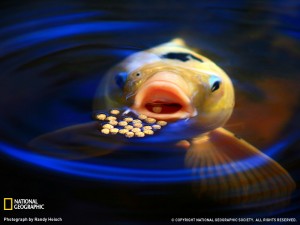Feed fish what they want observe them, listen to the fish. They will let you know whether they are hungry or not. 15-20 minutes after placing the food in the water for the fish to eat, there should be no floating food left. If there is food, you have fed them too much.
Fish are cold-blooded animals. Their metabolism is based on the temperature of the water they live in. Warmer water creates faster metabolisms. Fish will eat more and need more food to survive. Colder water creates slower metabolisms in fish. They will eat less food. In fact, at 50 F / 30 C you stop feeding goldfish and koi. Below 50 F / 30 C if they do swallow food, the food will spoil before it passes out of their long intestinal track. This leads to all types of problems sickness, diseases, digestive problems, etc. Note that normally they will not eat when it is this cold and the uneaten food will only spoil, clog and over load your filter system, disturb the pond balance and possibly create an unhealthy and detrimental situation. Thus note at 50 F / 30 C and below DO NOT FEED YOUR FISH!
Start feeding once a day as the temperature warms in the spring. When it warms, koi can be fed multiple times a day. As the weather cools in the fall, gradually slow down on the quantity till you stop at 50 F.
Koi/Carp are bottom-feeding fish in nature. The barbs on either side of their mouths are used to tactilely feel along the bottom of a lake for food. They are omnivores. An omnivore is a kind of animal that eats either other animals or plants. Naturally, their diet would consist of worms, crustaceans, plant life, etc. We have trained koi to come to the surface with floating food for our own enjoyment.
Koi food companies are doing their best to create dietary mixtures in their foods and for the most part they are doing a good job. And yet there is still a belief that the dietary needs of koi are still most optimally met by augmenting a variety of foods some proteins, plants, starch, etc. This can include not just pelleted/processed foods, but also fruit sliced oranges, grapefruit, watermelon, grains -rice, wheat, bread.

